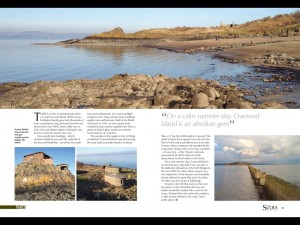 There’s a sense of abandonment when you visit Cramond Island. While human habitation literally goes back thousands of years (a prehistoric long cist burial chamber was uncovered in the 1940s), there’s little now to show of it and Mother Nature is doing her very best to reclaim the island as her own.
There’s a sense of abandonment when you visit Cramond Island. While human habitation literally goes back thousands of years (a prehistoric long cist burial chamber was uncovered in the 1940s), there’s little now to show of it and Mother Nature is doing her very best to reclaim the island as her own.
Once sturdy farm buildings—latterly summer holiday homes until the outbreak of the Second World War—are all but lost under trees and undergrowth. Gun and searchlight emplacements (along with generator buildings, supply stores and barracks) built by the British Army back in 1941, are now empty husks, weathered and covered in graffiti, their floors a patina of broken glass, rusted cans and the burnt shadows of camp fires.
The paradox in this neglect is that, all things considered, Cramond Island must rank among the most easily accessible island in Scotland, being barely three quarters out into the Firth of Forth and easily accessible by foot at low tide. That said, unwary visitors continue to be stranded by the rising water; during 2012, more than one third—25 out of 66—of the “shouts” (call outs) answered by the RNLI station at South Queensferry involved visitors to the island.
On a calm summer day, Cramond Island is an absolute gem, especially if you can take in the distinctive silhouettes of the Forth Bridges to the west. With few other visitors around, you can experience a level of peace and tranquility almost unheard of, given that you’re less than 10 miles from the centre of Edinburgh.
However, don’t let that fool you; there are few places on the island that offer any real shelter should the weather takes a turn for the worse. Perhaps that’s why, down the centuries, so little human habitation has really “stuck” to the island.
First published by The Scots Magazine (October 2013)